




Introduction
Genotype is the complete set of genes present in an organism’s DNA. It also refers to the genetic constitution of an organism. It determines the hereditary potentials and limitations of an organism from embryo formation towards adulthood. An organism’s genotype consists of a complex set of genes that are inherited from the parents. That's why they resemble their parents. A genotype of an organism is a complete heritable genetic identity, it is a unique genome which means every person has a genotype different from others.
Let's examine the most prevalent genetic characteristics.
Eye Shade: The most prevalent allele type for eyes is often brown. You are therefore more likely to have brown eyes if one parent has blue eyes and the other has brown eyes. However, if one of your grandparents had blue eyes, you could also have inherited that characteristic. An example of a recessive characteristic would be this.
Hair Shade: Inheritance of hair colour can also come from one or both parents. Because of the way genes operate, you may even have a different hue than both of them thanks to a grandparent-inherited characteristic. Genes can also be inherited through hair type and hairline form.
And many more like heights, bone structure, dimple etc.
What is the Definition of Genotype?
The genetic components that make up an organism's genotype. The alleles or genetic variants that a person carries in a certain gene or genetic area are sometimes referred to as a person's "genotype." The number of alleles a person can have for a particular gene depends on the ploidy, or number of copies of each chromosome, found in that species. Since humans are diploid (having two full sets of chromosomes), each individual has two alleles for each gene. When both alleles are the same, the genotype is said to be homozygous. When there are two different alleles, the genotype is said to be heterozygous.
Notes: Alleles: Alleles, which influence a particular characteristic in the progeny, can arise singly or in pairs. A gene's locus on a chromosome is where it may be discovered. For instance, two alleles that code for black eyes and brown eyes respectively decide the same attribute, eye colour.
Gene: Due to their DNA construction, genes serve as functional units of heredity. The DNA that makes up a chromosome contains several genes. Every gene has a unique set of instructions for coding proteins or performing a certain function. Genes, to put it simply, are what cause heredity.
Genotype Frequency Definition
Genotype frequency in a population is the total number of individuals with a given genotype divided by the total number of individuals in that population. In population genetics, the genotype frequency is the frequency of genotypes in a particular population. There are three possible genotypes which are homozygous dominant, homozygous recessive and heterozygous. For example:
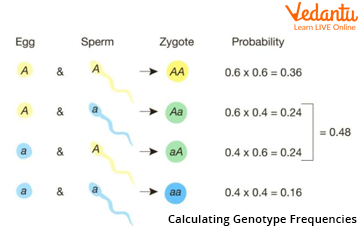
Genotypes Frequencies
Explanations: From this, we can conclude that AA will result from the union of egg A and sperm A. and in the next situation, if A & an are joined, it results in Aa, and so on. Therefore, by computing the probability, we may infer the genotypes.
The genotype frequency can be calculated by the Hardy-Weinberg equation which is based on the Hardy-Weinberg principle.
Hardy Weinberg Equation
Hardy Weinberg's principle mathematically explains the occurrence of gene frequency for any particular gene. According to this principle, the frequency of alleles remains constant throughout generations and the gene pool ( the total number of alleles in a population ) remains constant. This is known as genetic equilibrium.
The Hardy Weinberg equation is
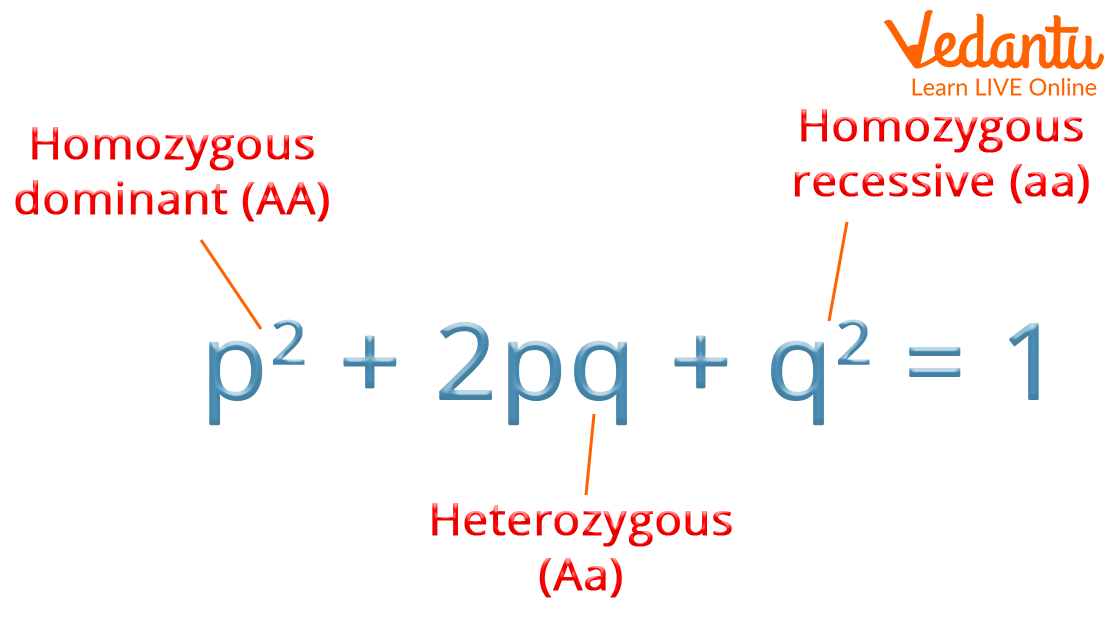
Hardy Weinberg Equation
There are five basic assumptions in Hardy Weinberg’s equation. These are:
No mutation: A mutation(modification) in a gene that prevents it from being translated into a functional protein and/or from being transcribed into RNA. For instance, a null mutation in a gene that typically encodes a certain enzyme results in the synthesis of either no enzyme at all or an enzyme that is not functioning.
Random mating: In population genetics, the term "random mating" is used. It represents a perfect scenario in which every member of one sex has an equal chance of finding love with every member of the other sex. Panmixia is the medical word for it.
No gene flow : Gene flow, also known as gene migration, is the transfer of genetic material (via interbreeding) from one population of a species to another, altering the make-up of the recipient population's gene pool.
Infinite population size: The term "infinite population" refers to a population that cannot be counted and in which there are no units that can be counted. The patient's body has an endless number of germs, which is an example of an infinite population.
No selection: Not having been picked or chosen Between the patients who were randomly picked and those who were not, there were no statistically significant differences in any of the clinically important variables.
Homozygous and Heterozygous Genotype
Homozygous and heterozygous are the terms used to describe allele pairs of a genome. Homozygous are those who have the same type of alleles and heterozygotes have two different types of alleles.
For example: If we consider a pea plant with two different characters, one is a dwarf plant and the other is a tall plant then the one which is a dwarf has a homozygous genotype, that is, tt. T
The tall plant will have both kinds of genotypes homozygous and heterozygous. Homozygous when TT alleles are present and heterozygous when Tt alleles are present.
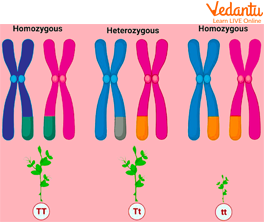
Homozygous and Heterozygous
Dominant and Recessive Alleles
Dominant alleles are those which can express themselves in the presence of any alleles (dominant or recessive) but recessive ones are only able to express themselves when both the alleles are recessive.
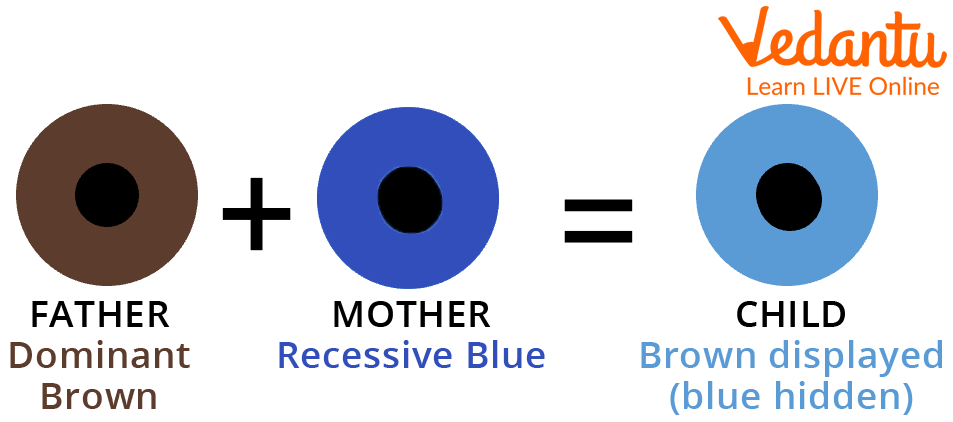
Dominant and Recessive Traits
Genotype Examples
There are three different types of genotypes. These are: homozygous recessive (tt), homozygous dominant (TT) and heterozygous (Tt).
Now let us discuss one example of genotype: Eye colour.
In this example, the allele is either brown or blue having one allele inherited from the mother and the other from the father. The brown allele is dominant, let this be B and the blue one is recessive and lets this be b.
Now, if the child inherits two different alleles Bb (heterozygous) then they will have brown eyes as the brown allele is dominant so it compresses the effect of recessive allele b.
If the child inherits blue eyes, then the genotype must be bb (homozygous) as the blue allele is recessive.
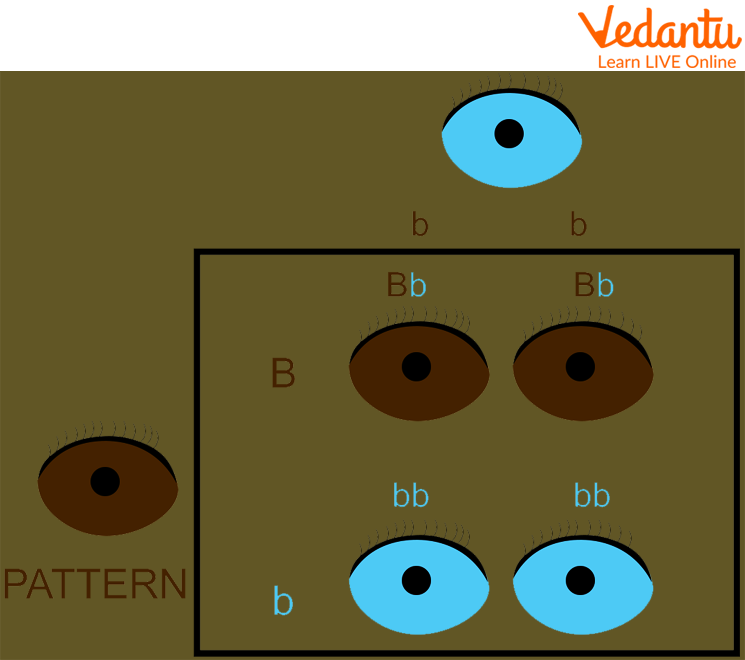
Cross Showing Brown and Blue Eyes
Some other examples of genotype are:
Hair colour
Height
Skin colour
Summary
Genotype is the entire genetic information present in the DNA of an organism. Examples of genotypes are skin colour, eye colour and height. Heterozygotes have two different types of alleles and homozygotes have the same type of alleles. Genetic frequency is determined by the Hardy Weinberg principle.
Solved Questions
Question 1. Where is the genotype located in our body?
Answer: Genotype means the type of genes present in an individual. In our body genes are located on the chromosomes which are present in the nucleus of the cell.
Question 2. Write three examples of a genotype.
Answer: The three examples of genotype are:
Eye colour
Hair colour
Height
Question 3. How many types of genotypes?
Answer: There are three different types of genotypes. These are: homozygous recessive (tt), homozygous dominant (TT) and heterozygous (Tt).
FAQs on Genotype Definition for Kids
1. Which blood group is the best?
O-negative blood is best. It is known as the universal blood group because it is safe for everyone to receive O-negative blood cells.
2. Can your genotype change?
The genotype of an organism is a unique property of an individual. It does not change throughout life. But sometimes due to some reasons the genotype of a person changes, it is known as mutation which causes changes in DNA.
3. How is genotype expressed?
Genotypes can be expressed by symbols, for example, bb, Bb or BB can be used to represent various types of genotypes.
4. Can a child have a different blood type than both parents?
Yes, the blood group of a child can be different from both the parents, for example, if both the parents have an AB blood group then the child can have A, B or AB blood group.
5. Why is genotype important to us?
Genotype is important to us as its study can help us to find various genetic disorders. It also helps to check the quality of drugs like which drugs to avoid, and which to use.









